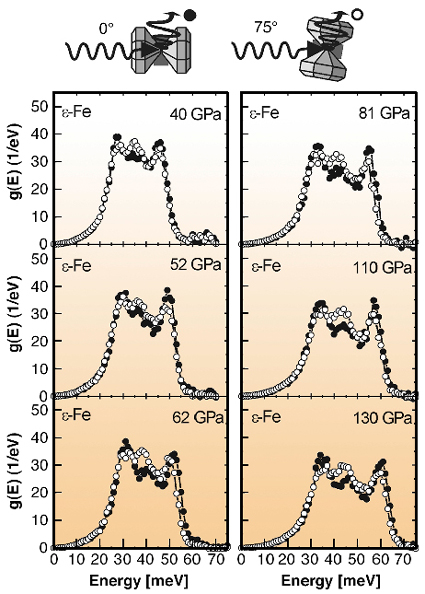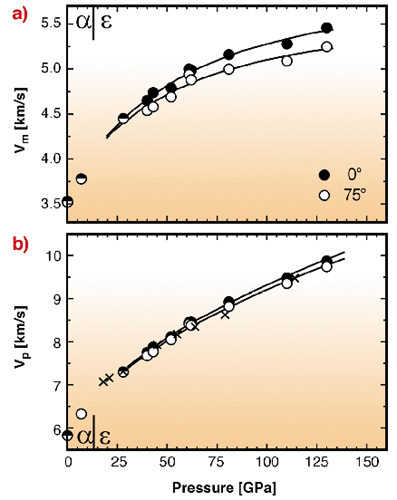- Home
- Users & Science
- Scientific Documentation
- ESRF Highlights
- ESRF Highlights 2004
- High Resolution and Resonance Scattering
- High-pressure Phonon Spectroscopy of Oriented hcp Iron
High-pressure Phonon Spectroscopy of Oriented hcp Iron
The hexagonal (hcp) high-pressure phase of iron (![]() -Fe) is the most relevant constituent of the Earth's inner core. The thermodynamic and elastic properties of this phase are therefore of actual geophysical interest.
-Fe) is the most relevant constituent of the Earth's inner core. The thermodynamic and elastic properties of this phase are therefore of actual geophysical interest.
Using Nuclear Inelastic Scattering (NIS) with the 14.413 keV transition of Fe-57, the phonon density-of-states (DOS) in hcp iron was measured for the first time up to 42 GPa at ID22N of ESRF [1]and later up to 153 GPa at the APS [2]. Using the texture of the pressurised sample, we developed a new method to study the orientation dependence of the phonon density-of-states in ![]() -Fe up to 40 GPa[3]. The use of texture enables a search for a possible anisotropy in the sound velocity. Here we report on such a high-resolution NIS study of oriented
-Fe up to 40 GPa[3]. The use of texture enables a search for a possible anisotropy in the sound velocity. Here we report on such a high-resolution NIS study of oriented ![]() -Fe up to 130 GPa.
-Fe up to 130 GPa.
Synchrotron radiation of 14.413 keV with a bandwidth of 3 meV was focused onto the sample of about 50 µm in diameter, contained in a Be gasket between the diamonds in the high-pressure cell [3]. NIS spectra were measured in two different directions, 0° and 75°, with respect to the axis of the diamonds, which is also the preferred c-axis orientation of the ![]() -Fe sample. NIS spectra of
-Fe sample. NIS spectra of ![]() -Fe were recorded from 28 GPa up to 130 GPa. The phonon-DOS spectra, derived from the NIS spectra [1,3], are shown in Figure 18. They exhibit clear pressure-induced shifts of their characteristic peaks to higher energy as well as characteristic differences for the two orientations.
-Fe were recorded from 28 GPa up to 130 GPa. The phonon-DOS spectra, derived from the NIS spectra [1,3], are shown in Figure 18. They exhibit clear pressure-induced shifts of their characteristic peaks to higher energy as well as characteristic differences for the two orientations.
 |
|
Fig. 18: (above) Transmission of the SR beam through the Fe sample at 0° and 75° with respect to the diamond anvil axis in the high-pressure cell. (below) Phonon-DOS g(E) of |
To explain the orientation dependence of the observed phonon DOS, theoretical calculations of the phonon dispersion relations and phonon-DOS were performed for ![]() -Fe at 40 GPa [3]. In addition, we demonstrated that the observed texture effects can be enforced by difference spectra, producing projected phonon-DOS as seen by NIS parallel and perpendicular to the hexagonal c-axis [3].
-Fe at 40 GPa [3]. In addition, we demonstrated that the observed texture effects can be enforced by difference spectra, producing projected phonon-DOS as seen by NIS parallel and perpendicular to the hexagonal c-axis [3].
From the thermodynamic and elastic parameters derived from the phonon-DOS spectra of Figure 18 we concentrate here on the mean sound velocity vm, connected in the Debye model with the longitudinal and transversal sound velocity, vp and vs, by 3/(vm)3 = 1/(vp)3 + 2/(vs)3. The sound velocities vm of ![]() -Fe, derived from the low-energy range (0 - 15 meV) of the DOS are shown in Figure 19. They exhibit a systematic difference between the two directions, increasing with pressure and amounting to about 4% at 130 GPa. One can use the known bulk modulus K and shear modulus G of
-Fe, derived from the low-energy range (0 - 15 meV) of the DOS are shown in Figure 19. They exhibit a systematic difference between the two directions, increasing with pressure and amounting to about 4% at 130 GPa. One can use the known bulk modulus K and shear modulus G of ![]() -Fe to derive the corresponding vp and vs values from the measured vm values [2]. The results for vp are shown in Figure 19 and exhibit a smaller, but well-resolved difference. The 75° data agree nicely with vp data obtained by IXS, a complementary technique (see D. Antonangeli et al., preceding article). All other elastic parameters derived from the full phonon-DOS exhibit similar differences indicating that the lattice is stiffer parallel to than perpendicular to the hexagonal c-axis. One reason for this behaviour might be the observed decrease of the c/a ratio with pressure.
-Fe to derive the corresponding vp and vs values from the measured vm values [2]. The results for vp are shown in Figure 19 and exhibit a smaller, but well-resolved difference. The 75° data agree nicely with vp data obtained by IXS, a complementary technique (see D. Antonangeli et al., preceding article). All other elastic parameters derived from the full phonon-DOS exhibit similar differences indicating that the lattice is stiffer parallel to than perpendicular to the hexagonal c-axis. One reason for this behaviour might be the observed decrease of the c/a ratio with pressure.
 |
|
Fig. 19: a) Mean sound velocity vm in |
Bearing in mind that the present data of vm and vp were obtained from a textured sample (and not from a single crystal) and that the NIS probability varies with cos2 ![]() , where
, where ![]() is the angle between the k-vector of the incident synchrotron radiation and the polarisation vector of the excited or annihilated phonons, the experimentally observed vm values at 0° and 75° provide only lower limits of the actual difference in vm and the derived vp and vs values as seen parallel and perpendicular to the c-axis. When we derive vm and, accordingly, vp and vs from the projected DOS, we obtain considerably larger differences, up to 10% for vm and vp at 130 GPa [4]. An exact determination of the difference depends on the degree of texture in the
is the angle between the k-vector of the incident synchrotron radiation and the polarisation vector of the excited or annihilated phonons, the experimentally observed vm values at 0° and 75° provide only lower limits of the actual difference in vm and the derived vp and vs values as seen parallel and perpendicular to the c-axis. When we derive vm and, accordingly, vp and vs from the projected DOS, we obtain considerably larger differences, up to 10% for vm and vp at 130 GPa [4]. An exact determination of the difference depends on the degree of texture in the ![]() -Fe samples, which will be determined independently in future studies. The present data demonstrate the high-resolution power of NIS for precise determination of the sound velocities and other elastic parameters well above 100 GPa.
-Fe samples, which will be determined independently in future studies. The present data demonstrate the high-resolution power of NIS for precise determination of the sound velocities and other elastic parameters well above 100 GPa.
References
[1] R. Lübbers et al., Science 287, 1250 (2000).
[2] H.-K. Mao et al., Science 292, 914 (2001).
[3] H. Giefers, et al., High Pressure Research 22, 501 (2002).
[4] H. Giefers, PhD thesis (Paderborn, 2004); H. Giefers et al., in preparation.
Authors
H. Giefers (a,b), G. Wortmann (a), A.I. Chumakov (c), D. Alfè (d).
(a) Department Physik, University of Paderborn (Germany)
(b) Present address: Department of Physics, University of Nevada, Las Vegas (USA)
(c) ESRF
(d) University College London (UK)



